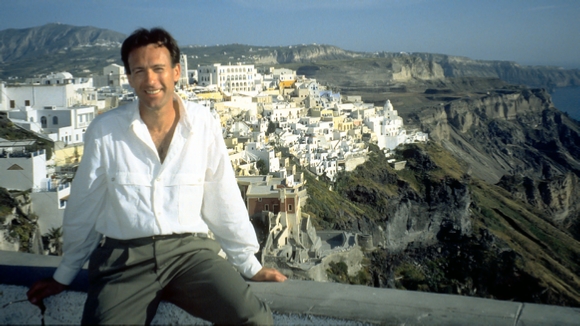

For more information: Recommended Links | Frequently Asked Questions
Copyright © 2018 by Michael Ray Brown. All rights reserved.
“First rate analysis at a cut-rate price.”
— Creative Screenwriting



How did you get started with script analysis and consulting?
Everyone seemed to be writing screenplays, and somebody had to read them. Many producers simply did not have the time. A director friend showed me a studio reader’s report. Using that as a model, I wrote some sample coverage of my own, analyzing a novel I had just read. I would walk onto The Burbank Studios lot (home of Warner Bros. and Columbia Pictures) and go around to the producers’ bungalows, introducing myself, handing out my business card and that sample. My first year I also sent out more than 500 letters, each one individually typed. (This was before computers.) I eventually won over more than a dozen producer clients, including Casablanca Filmworks, American Cinema, The Begelman/Fields Co., and John Kemeny, along with several agencies. I would get a call in the afternoon, drive up to Burbank to pick up a 500-page book, type up a 20-page coverage report, and have it back on the producer’s desk by 10 a.m. the next day. And for this I would be paid $50. Considering that half the time I would be hustling to find my next client, this was a very hard way to make a living.
My immediate goal was to land a position as a studio reader. Story analysts, as they are called, are organized under the International Alliance of Theatrical Stage Employees, the same union that serves below-the-line technicians and craftspersons, such as camera operators, set designers, sound engineers, etc. The wages and benefits of a Union story analyst are such that it’s possible to actually make a living (and a pretty decent one) as a reader. I started hanging out at the Universal Studios story department, and became good friends with the story editor. When he found out that I had been reading scripts for Hanna-Barbera Productions, he called the business manager of the Story Analysts Guild to find out if they were a Union signatory. Sure enough, they were. Because I had worked more than 30 days for a signatory, I was eligible for placement on the Producers Availability Roster, and I could join the Union. At that time, candidates also had to be vetted by a Qualifications Board comprised of story editors from the studios.
Before I had a chance to work for a studio, though, I got hired by Metromedia Producers Corporation as their assistant story editor. One of the studio readers I’d met had been offered the job, but he turned it down. A year later I was running the story department, developing movies and miniseries for the networks. I had an office next to Edgar Scherick, where Scott Rudin was starting to make a name for himself as a producer. Four years later, the company began a transition that would see much of their assets sold to Fox as part of their then-fledgling network. Over the next 15 years I worked for nearly every major studio as a story analyst. When MGM reorganized in 1998, as an 8-year veteran of the studio I had an opportunity to start my own business as a consultant. When a feature article in Creative Screenwriting magazine “Analyzing the Analysts” rated me third out of 24 and their “Best Buy,” my business really took off.
What are the most common mistakes that writers make?
A common mistake I see in screenplays by new writers is giving us information that would not be available to someone watching a movie. They tell us what a character knows, thinks, feels, realizes, etc. They give us backstory in description. They tell us what a character is looking for, waiting for, or trying to do. They describe a character in terms of their profession, or what relationship they have to another character. Whenever we go to the cinema, no one steps in from the wings to give us that information. It must all be conveyed through the characters’ actions and/or dialogue. That’s not to say the characters must wear their hearts on their sleeves, and openly express their thoughts and feelings. That’s called being “on the nose,” and it’s another common mistake. In real life (and in the movies) people rarely say what’s on their minds and in their hearts. The greater a character’s emotional investment in a situation, the more reticent they tend to be. The best dialogue has layers of subtext. But perhaps the most common mistake is underestimating the difficulty of writing a workable script. Screenwriting is all about rewriting.
What’s the biggest piece of advice you could give to an aspiring screenwriter right now?
Writers seem to be taking less responsibility for their work now. They tend to read less, prepare less, and proofread less than they used to. Consequently, there’s much more for an analyst to criticize. For example, I’m now forced to school writers on grammar, spelling, punctuation, and other basics. I’ve detected less of a desire among writers to carve out a career than to make a quick buck. This results in work that’s far from professional. Many writers seem less interested in telling a good story than in crafting a thrill ride. This results in work that’s devoid of passion, with no coherent theme driving it. All this makes my job harder. Before I can begin to offer any solutions, I have to figure out what the writer is trying to say, even if the writer doesn’t know, and doesn’t care. Think of screenwriting as a craft that requires diligent study and practice to master, not as a lottery ticket.


This excerpt is reprinted here with the permission of James G. Sarantinos, editor-in-chief of Creative Screenwriting magazine.


Growing up in Des Moines, Iowa, story analyst Michael Ray Brown hunted for crawdads in a creek, and whiled away days reading comic books in a treehouse. His interest in storytelling didn’t reveal itself until Brown was halfway through high school.
“I had been a ‘D’ student, unmotivated and a daydreamer. But then a remarkable English teacher opened my eyes to story structure: inciting incident, technical climax, dramatic climax, transformational arcs, etc. And something clicked,” recalls Brown. “It turned my life around. That teacher was like the Robin Williams character in Dead Poets Society.”
Brown currently runs his own consulting firm, Story Sense. We caught up with him to chat about his Screenwriting Structure Checklist, his go-to screenplays that every screenwriter should read, and his biggest piece of advice for aspiring writers.
by Brianne Hogan
Not a Lottery:
Michael Ray Brown on Screenwriting
 Continue on Creative Screenwriting
Continue on Creative Screenwriting| Development Notes |
| Oral Consultation |
| Studio-style Coverage |
| Selling Synopsis |
| Proofreading |
| Sample Script Analysis |
| Sample Coverage |
| Sample Selling Synopsis |
| SolPix Interview |
| Creative Screenwriting Interview |
| Scriptwriter Interview #1 |
| Scriptwriter Interview #2 |
| Scriptwriter Interview #3 |
| Scriptwriter Interview #4 |
| Elements of a Great Script |
| Margin Settings |
| Scene Headings |
| Slug Lines |
| Description |
| Character Cues |
| Dialogue |
| Personal Direction |
| Transitions |
| Flashbacks |
| Montages |
| Telephone Calls |
| Registration |
| Software |